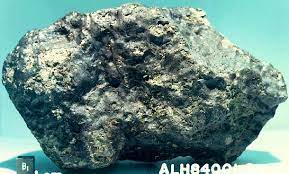Meteorite (ALH) 84001:

A new study published in the journal Science, offers an explanation for the existence of organic compounds on the surface of Meteorite called (ALH) 84001.
- It landed on Earth from Mars in 1984, and can possibly unravel the existence of life on Mars (Red Planet).
- Meteorite named Alan Hills (ALH) 84001 was found in December, 1984 in the Far Western Icefield of Allan Hills in Antarctica by a US meteorite hunting expedition.
- At the time of its discovery it was recognised as the most unusual rock collected.
- It was described at the time of discovery as, shaped like a rounded brick or a large potato, about 6 inches long by 4 inches by 3 inches, and was partly covered with black glass.
- In 2021, NASA’s Perseverance rover collected the first sample of Martian rock.
- It can be said with certainty that the meteorite did come from the Red planet because of the presence of traces of certain gases that are just like the Martian atmosphere.
- The study posits that the organic compounds found in the meteorite were a result of the interactions between water and rocks that occurred on Mars.
- These interactions were similar to those that happen on Earth.
- These kinds of non-biological, geological reactions are responsible for a pool of organic carbon compounds from which life could have evolved and presents a basis that must be taken into consideration when searching for evidence of past life on Mars.
- The search for life on Mars is not just an attempt to answer the question ‘are we alone, but also It relates to early Earth environments and addresses the question of ‘where did we come from.




